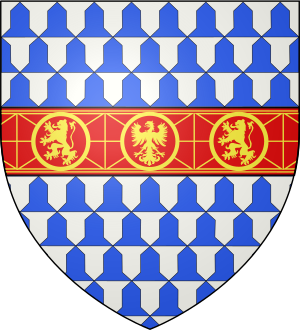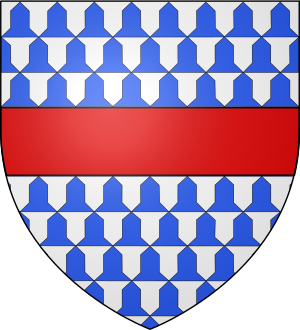Baron Marmion facts for kids
The Marmion family was a powerful noble family in England and Normandy. Over time, they held four different types of baronies. A "barony" meant they were important landowners with special rights and duties to the King. These included two feudal baronies, one barony that was only temporary, and one created by a special royal order called a "writ."
Contents
Feudal Baronies: Land and Power
A feudal barony was a very old type of title. It meant a family held a large amount of land directly from the King. In return, they had to provide knights and other services. The main castle or town of a barony was called its caput.
Tamworth: A Key Feudal Barony
The first feudal barony for the Marmions was in Tamworth. It was given to Roger or Robert de Marmion around 1110-1114. He was already an important figure in Normandy, controlling Falaise Castle. The main place for this barony was Tamworth Castle. Later, a branch of the family also gained land in Winteringham in North Lincolnshire.
Llanstephan: A Welsh Stronghold
Another feudal barony was given to Roger Marmion in Llansteffan during the Norman invasion of Wales. The family was rewarded for their help in the wars. Llansteffan Castle was the caput of this barony. It played a big part in the battles against the Welsh. This barony later passed to the de Camville family through marriage.
Baronies by Writ: Royal Summons
A "barony by writ" was created when the King officially summoned someone to attend Parliament. This meant they were considered a baron.
Torrington: A Short-Lived Barony
In 1264, William Marmion was called to Simon de Montfort's Parliament as "Baron of Torrington." However, this was during a time of rebellion. After the rebels lost the Battle of Evesham in 1265, William was never called to Parliament again. So, under modern law, this summons didn't create a lasting noble title.
Winteringham: A Lasting Title
The barony of Winteringham was created by writ for John Marmion (who died in 1322). This title continued for several generations. The last baron, Robert Marmion (died around 1360), had no children. Because of this, the barony became "abeyant." This means the title was put on hold, waiting for a future heir to claim it. Parts of the barony eventually passed to his sisters' descendants.
The King's Champion: A Special Role
The Marmion family is famous for a special role: the King's Champion. Legend says they were Champions in Normandy before coming to England.
Defending the King's Honor
In 1140, Robert Marmion defended King Stephen's castle at Falaise. This might show that the Champion title was more than just symbolic back then. It meant actually fighting for the King. Since Normandy was still very important to the English Kings, it made sense to have a "Champion of Normandy and England."
The Three Swords Badge
Philip Marmion (died 1291) used a "3 Swords" badge. This badge later became a symbol for the hereditary Champions of England, used by the Dymoke family. By 1328, Tamworth Castle was held by the duty of its owner. This duty was to appear fully armed on the King's best horse at his coronation. The Champion would offer to fight anyone who questioned the King's right to the throne.
Passing the Title
Philip Marmion had no sons who could legally inherit his titles. So, the duty of King's Champion and the manor of Scrivelsby passed to the Dymoke family. This happened through Philip's granddaughter, Margaret Ludlow.
Notable Marmion Barons
Here are some of the important Marmion family members who held these baronies:
Barons of Tamworth (Feudal)
- Robert Marmion (died 1144): The first baron.
- Robert Marmion, 2nd Baron Marmion of Tamworth (died before 1181): Son and heir.
- Robert Marmion, 3rd Baron Marmion of Tamworth (died before 1218): Son and heir. He was a Chief Judge of England and a sheriff. He was also involved in the First Barons' War.
- Robert Marmion, 4th Baron Marmion of Tamworth (died 1248): Son and heir. Also a rebel in the First Barons' War.
- Philip Marmion, 5th Baron Marmion of Tamworth (died 1291): Son and heir. He was loyal to the King during the Second Barons' War. He was the last Marmion to hold the King's Champion role.
Barons of Llanstephan (Feudal)
- Roger Marmion (died around 1129): Lord of Fontenay, granted Llanstephan.
- Robert Marmion, 1st Baron Marmion of Tamworth (died 1143): Eldest son of Roger.
- Geoffrey Marmion: Youngest son of Roger. He was granted Llanstephan by his nephew. He also supported the Knights Templar.
- Albreda: Geoffrey's only daughter and heir. She married William de Camville, and the barony passed to his family.
Barons of Winteringham
- Robert Marmion, 1st Baron Marmion of Winteringham (died 1241): He was a rebel in the First Barons' War.
- William Marmion, 2nd Baron Marmion of Winteringham (died 1274): Son and heir. He was a rebel in the Second Barons' War.
- John Marmion, 3rd Baron Marmion of Winteringham (died 1322): Son and heir, created a baron by writ.
- John Marmion, 4th Baron Marmion of Winteringham (died 1335): Son and heir.
- Robert Marmion, 5th Baron Marmion of Winteringham (died around 1360): Son and heir. He died without children, and the barony became abeyant.
Barons of Torrington (Purported)
- William Marmion: Summoned to Parliament in 1264, but the title was not continued.




